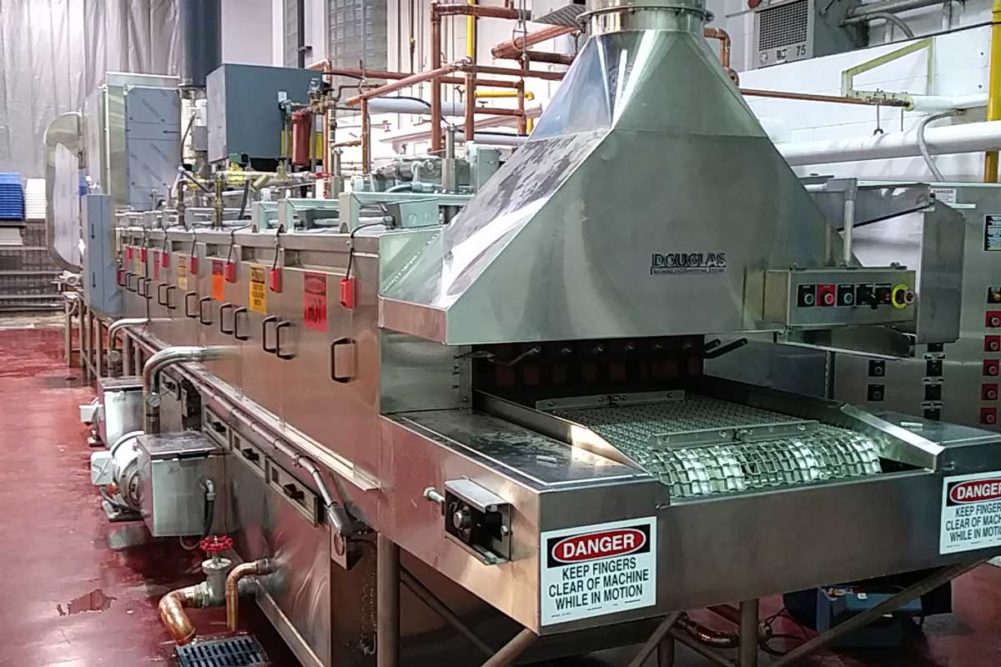A tray or basket may seem like a straightforward thing, but when approaching these assets with sanitation in mind, things can get interesting. When creating a tray or basket, suppliers must balance the asset’s function as well as features that will make it easier to use, whether that’s easy cleaning or ergonomically friendly.
“In a commercial bakery, first you’re trying to make sure you protect a product that can be so delicate,” said Patrice Painchaud, vice president of sales and marketing, Rexfab. “You have to keep it light because that’s a cost implication. You also want to design it so it doesn’t waste space during transportation or storage. Now that they are all being washed, that’s the next piece of tray design.”
When creating trays that are easier to clean, the features should mimic that of sanitary design for equipment by eliminating places where dirt, bacteria and water can hide or be difficult to remove.
“Trays and baskets are designed in such a way to minimize ‘masking’ of the surfaces to be cleaned and prevent wash or rinse water from being trapped within the tray or basket, allowing for better cleaning and drying,” said Kevin Quinn, sales manager, Douglas Machines Corp.
The same crevices that can harbor dirt and bacteria can also trap water after the tray or basket is dry, and that isn’t any better than trapped dirt. Standing water will encourage bacteria to flourish, so transportation assets are often created to eliminate these dirt and water traps.
Instead, these suppliers are building assets with flow-through design so the water drains out of the tray or basket and the blower can remove residue.
The next step? Going further with antimicrobial materials. An additive package is available now to be mixed in with a tray’s or basket’s plastic, but currently it’s a costly option.
“There’s the plastic and then the color additive,” Mr. Painchaud said. “You might have UV and antioxidant stabilizers, and then you can actually add in an antimicrobial. It’s an option worth mentioning, but it can be cost-prohibitive.”
New trays are supposed to make it easier for washer/dryer systems to sanitize trays and baskets. And as tray and baskets evolve to accommodate FSMA, washer/dryer systems, too, must adapt to the new assets.
“AMF Bakery Systems custom designs the water sprayer configuration to pressure wash all around the tray or basket in a full 360-degree all axis,” said Bobby Martin, executive product manager, AMF Bakery Systems. “There is also a guiding system that will adapt to the basket’s dimensions to a certain min/max overall degree.”
Douglas Machines Corp.’s washer and dryer systems also can be customized to suit a bakery’s trays and baskets. In the company’s tunnel washer, the tray determines the spray pattern to optimize the clean. The company engineers its Blow-Off Drying systems with single or multiple blowers and heated air drying.
These machines take the muscle work out of keeping these plastic assets food safe. AMF’s Basket Washing and Drying System uses high-performance nozzles with filtered hot water to clean baskets. The water’s temperature is closely controlled for wash efficiency, and a moisture eliminator system dries the baskets by recirculating air and eliminating excess moisture.
Douglas Machines Corp.’s rack washer uses high-velocity stainless steel V jets to remove stubborn soils and contaminants.
“Wash cycle times are selected depending on soil conditions,” Mr. Quinn said. “Recirculated detergent wash water reduces water use and provides quicker turnaround time to get those racks and baskets back in use.”
After each wash cycle, the system rinses with a hot water sanitizing rinse, and that water is routed to the recirculated wash tank to freshen it each cycle. Water reduction and sustainability are at the forefront of keeping trays and baskets clean. Minimizing water usage not only saves the bakery money and benefits the environment, but it minimizes the potential for bacteria growth.
“The use or presence of water and moisture in a facility is a significant risk factor for contamination,” Mr. Quinn said. “If present, standing water may allow pathogen growth and is unfortunately an excellent and efficient way to spread pathogens throughout a facility. Having an automated washing and sanitizing system reduces the amount of water being used while keeping it contained to a small footprint.”
This article is an excerpt from the February 2020 issue of Baking & Snack. To read the entire feature on trays and baskets, click here.






